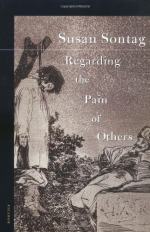
|
| Name: _________________________ | Period: ___________________ |
This test consists of 5 multiple choice questions, 5 short answer questions, and 10 short essay questions.
Multiple Choice Questions
1. In discussing images that remind us of death, Sontag references a particular 1943 photograph. What is the subject of this photograph?
(a) The empty trenches.
(b) A little boy in the Warsaw Ghetto.
(c) The mushroom clouds.
(d) The collapsed Twin Towers.
2. Sontag suggests that, for the most part, photographs received more serious attention when placed in which of the following scenarios?
(a) Books.
(b) Galleries.
(c) Museums.
(d) Newspapers.
3. Which of the following does Sontag suggest is an ethical act?
(a) Fighting.
(b) Remembering.
(c) Loving.
(d) Mourning.
4. In order to take pleasure in suffering, Sontag argues that one must necessarily have which of the following?
(a) Deep seated feelings of misanthropy.
(b) A sense of moral or intellectual superiority.
(c) A sadistic streak characteristic of serial killers.
(d) Distance from the source of suffering.
5. According to Sontag, people are less responsive to images of violence in which of the following contexts?
(a) Armed conflicts amassing the deaths of military personnel.
(b) Instances of mass casualty.
(c) Times of relative peace in one's home nation.
(d) Times of seemingly unending war.
Short Answer Questions
1. What sentiment concludes the book?
2. Sontag begins Chapter 9 with which of the following assertions?
3. Using the example of Ground Zero, Sontag argues that photographs have the power to do which of the following to their subject?
4. Sontag claims that sentimentality is often accompanied by which of the following?
5. Although Sontag is pessimistic about the broad effects of atrocity photographs, she did mention one positive outcome. What was it?
Short Essay Questions
1. How does our contemporary view of suffering differ from earlier, more traditional Western views?
2. According to Sontag, why is there no museum dedicated to the victims of the slave trade?
3. What does Sontag mean when she said that photographs transform?
4. How does Sontag refute claims that photography is somehow inherently more voyeuristic than other forms of observation?
5. Sontag contrasts the perceived number of atrocities now with the number from years ago, and makes a specific claim about the rate of atrocity. Discuss this assertion.
6. Sontag claims that there is historical evidence to suggest that, despite contemporary belief, war has always been the norm, and peace the exception to that norm. Discuss one of the examples Sontag provided.
7. Why does Sontag refer to the argument that image-glut desensitizes us to images of suffering as "conservative"?
8. What is unusual about Wall's "Dead Troops Talk (A Vision After an Ambush of a Red Army Patrol near Moqor, Afghanistan, Winter 1986)?" Discuss two aspects of the work that separate it from others like it.
9. Sontag discusses Sebastiao Salgado's series entitled "Migrations: Humanity in Transition" and points out one very problematic effect of the series. Discuss this effect.
10. According to Sontag, how does Goya's "The Disasters of War" differ from most depictions of mutilated and tortured bodies?
|
This section contains 1,122 words (approx. 4 pages at 300 words per page) |

|




